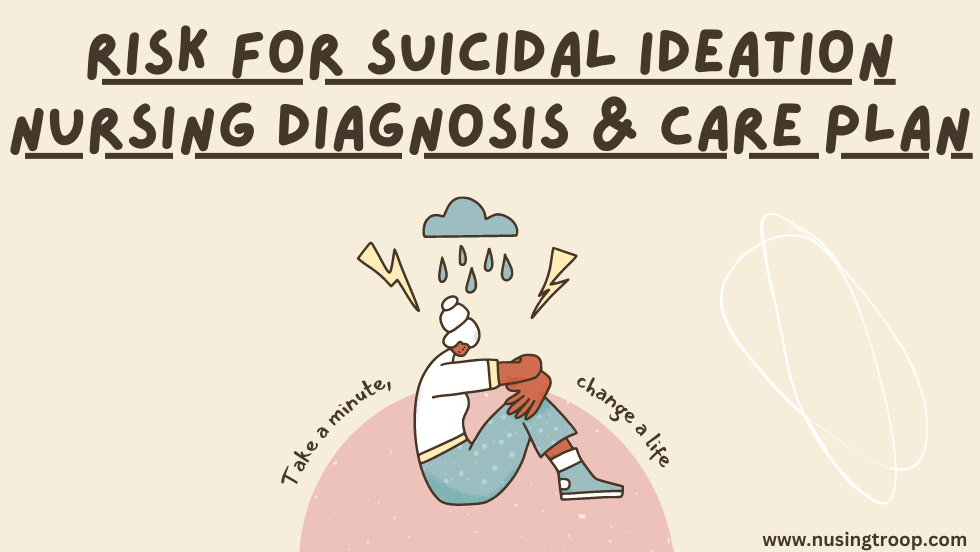Suicidal behavior is a severe mental health issue that can have devastating consequences.
It’s hard to know how to help those suffering from suicidal thoughts and behaviors, especially when they don’t want help or talk about it.
Our nursing diagnosis and care plans provide the guidance you need to create an effective treatment plan for your patients struggling with suicidal thoughts and behaviors. Our comprehensive approach includes evidence-based strategies for assessment, intervention, prevention, education, monitoring, follow-up care, and more. With our resources, you can be confident that you’re giving the best possible care for your patients.
Table of Contents
Introduction of Suicide And Suicidal Behavior
Suicide is taking one’s own life, and suicidal behavior is when an individual deliberately acts in a way that could lead to their death. Suicide can occur at any age but is most common among adolescents and young adults.
Suicidal thoughts or behaviors may be caused by mental illnesses such as depression, bipolar disorder, anxiety disorders, post-traumatic stress disorder (PTSD), or substance use disorders.
Nurses need to recognize the warning signs of suicide, which include threats of self-harm, talking about feeling hopeless or having no reason to live, increased alcohol or drug use, withdrawing from friends or activities they once enjoyed, and giving away prized possessions.
Pathophysiology
Environmental, psychological, and biological factors may cause suicidal behavior. Mental illness is often present in individuals who attempt or complete suicide. The most common mental health conditions associated with suicidal thoughts and behaviors are depression, bipolar, anxiety, and substance use disorders.
Genetics can also increase an individual’s risk for suicide, as specific gene variants have been linked to an increased risk of suicidal behavior.
Signs and Symptoms of Suicidal Ideation
- Talking about wanting to die or killing oneself
- Expressing hopelessness or having no reason to live
- Acting recklessly, such as engaging in risky behaviors
- Increasing alcohol and drug use
- Withdrawing from friends, family, and activities they once enjoyed
- Giving away prized possessions
- Feeling trapped with no way out
Complications of Suicidal Ideation
- Increased risk of suicide
- Depression or other mental health disorders
- Substance abuse or addiction
- Self-harm behaviors, such as cutting
- Feelings of guilt and shame
Causes
Suicide and suicidal behaviors commonly occur in people with one or more of the following:
- Bipolar disorder
- Stressful life issues, such as severe financial or relationship problems
- Post-traumatic stress disorder (PTSD)
- Schizophrenia
- Borderline personality disorder
- Depression
- Drug or alcohol use
- History of physical, sexual, or emotional abuse
Individuals who attempt suicide may do so to escape an overwhelmingly tricky situation. Many who try suicide are seeking relief from the following:
- Feeling embarrassed, guilty, or like a responsibility to others
- Feeling like a victim
- Feelings of refusal, loss, or loneliness
Suicidal behaviors may happen when there is a state or event that the person finds overwhelming, such as:
- Aging (An older person has the highest rate of suicide)
- Emotional trauma
- Physical severe illness or pain
- Death of a loved one
- Drug or alcohol use
- Unemployment or money problems
Risk factors for suicide in teenagers include:
- History of hurting themselves on purpose
- History of being neglected or abused
- Romantic breakup
- Romantic breakup
- Access to guns
- A family member who completed suicide
- Living in communities where there have been recent outbreaks of suicide in young people
The rate of suicide among men is higher than that among women, yet women are twice as likely to attempt suicide. Most attempts do not lead to death; many are cries for help.
Specific methods used, such as poisoning or overdosing, make rescue possible. Men often choose more violent means, such as shooting themselves, which makes their chances of survival much lower.
When a person attempts or completes suicide, those close to them might feel responsible and become angry with the deceased. It’s important to remember that people who attempt suicide may mistakenly think they’re doing their loved ones a favor by removing themselves from this world.
Risk Factors
Risk factors are events or conditions that make it more likely that someone will attempt suicide. They include:
- Mental health disorders, such as depression, bipolar disorder, schizophrenia, anxiety, and substance use disorders
- Social isolation and lack of support from family and friends
- Traumatic experiences such as physical or sexual abuse
- Access to lethal means such as guns
- Previous suicide attempts
- Family history of suicide
- Chronic pain or terminal illness
Treatment for Suicidal Ideation
Suppose a patient is experiencing suicidal thoughts but is not in immediate danger. In that case, their doctor and therapist may suggest a combination of psychotherapy, medication, and lifestyle adjustments to reduce the risk of suicide.
- Psychotherapy. Psychotherapy is a therapy in which the patient is taught coping skills to cope with suicidal thoughts. Psychotherapy can be done either individually or in a group setting. The therapist may also work with family members to help them better understand and support the patient.
- Medications. The doctor might also recommend medications, such as antidepressants, antipsychotics, and antianxiety drugs, to treat the underlying mental health disorder causing suicidal thoughts.
- Lifestyle changes. The doctor and therapist may also recommend lifestyle changes, such as regular exercise, avoiding alcohol and drugs, eating a healthy diet, and getting adequate sleep. All of these can help reduce stress levels and improve mood. Follow-up care: Follow-up care
Suicidal Ideation Care Plan
Assessment
Subjective data
- Risk factors
- history of suicide attempts
- Current life stressors
- Mental health issues or disorders
- Substance abuse or addiction
Objective data
- Clinical assessment
- lab work, imaging
- other diagnostic tests
Nursing Diagnosis for Suicidal Ideation
Risk for self-harm related to feelings of despair and hopelessness
Suicide is a complex and devastating phenomenon that affects countless individuals each year. One of the significant indicators of suicidal behavior is the presence of suicidal ideation, which can be defined as thoughts, behaviors, or plans related to ending one’s own life. Nursing professionals, in particular, have an essential role in identifying and addressing suicidal ideation.
A typical nursing diagnosis for patients exhibiting suicidal ideation is “risk of self-harm related to feelings of despair and hopelessness.”
Assessing and understanding the reasons behind suicidal thoughts and behaviors is paramount to providing effective treatment and support for individuals struggling with mental illness. It is crucial to approach these situations with empathy, understanding, and a willingness to help patients find hope and meaning in life.
Ineffective coping is related to a lack of adaptive coping skills.
Ineffective coping is another common nursing diagnosis for those exhibiting suicidal ideation. This diagnosis suggests that the patient has been unable to effectively cope with life stressors and other difficult situations, leading to increased despair and hopelessness.
To address this problem, the nurse should help the patient develop or identify adaptive coping skills that can be used when faced with challenging circumstances.
These may include relaxation techniques, problem-solving strategies, journaling, and seeking social support. Additionally, the nurse should provide the patient with resources to assist in developing these skills, such as books, online courses or workshops, or therapy sessions.
Imbalanced nutrition related to anorexic behavior due to depression
Depression is a typical mental health disorder that can lead to suicidal ideation. It is also well known to cause changes in eating habits, such as anorexia or overeating, which can significantly impair the body’s ability to get necessary nutrients.
As a result, a nursing diagnosis of “imbalanced nutrition related to anorexic behavior due to depression” may be appropriate for those exhibiting suicidal ideation.
To address this problem, the nurse must assess the patient’s diet and recommend dietary changes to promote better overall health. Additionally, providing support and resources for treating the underlying depression can help reduce feelings of hopelessness and improve nutritional intake.
Nursing Interventions for Suicidal Patients
- Provide a safe environment free from potential means for self-harm
- Encourage the expression of feelings in a safe manner
- Assist in developing adaptive coping skills
- Provide client education about mental health disorders and substance abuse
- Teach effective communication and problem-solving skills
- Refer the client to support groups and peer counseling programs
- Monitor for signs of suicidal ideation or behavior
- Provide referrals for psychotherapy or psychiatric care as necessary.
- Involve family members and friends in the treatment plan.
- Provide emotional support and reassurance to the patient
- Encourage healthy lifestyle changes, including regular physical activity, adequate sleep, a balanced diet, and avoiding alcohol and drugs.
What is the Nanda risk for hopelessness?
If a patient feels down and out upon arrival, the NANDA-International Nursing Diagnosis of Hopelessness (00124) can be applied. This disorder is characterized as an individual’s subjective state in which they perceive no alternatives or personal choices and lack the energy to act on their behalf. The defining characteristics typically associated with this diagnosis include decreased effect and response to stimuli and passivity.
Final Words
Nursing diagnosis of suicide ideation is a severe and complex issue. It can have long-term health, emotional, and psychological effects on an individual’s life.
As such, nurses need to be knowledgeable in assessing and treating suicidal ideation while being compassionate and understanding toward individuals struggling with this condition. Proper nursing interventions are essential for helping these patients find hope in their lives and move forward positively.
References:
https://en.wikipedia.org/wiki/Suicidal_ideation
https://www.mayoclinic.org/diseases-conditions/suicide/symptoms-causes/syc-20378048
Mrs. Marie Brown has been a registered nurse for over 25 years. She began her nursing career at a Level I Trauma Center in downtown Chicago, Illinois. There she worked in the Emergency Department and on the Surgical Intensive Care Unit. After several years, she moved to the Midwest and continued her nursing career in a critical care setting. For the last 10 years of her nursing career, Mrs. Brown worked as a flight nurse with an air ambulance service. During this time, she cared for patients throughout the United States.

